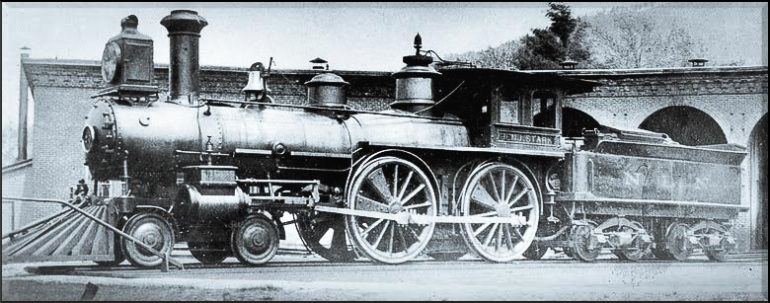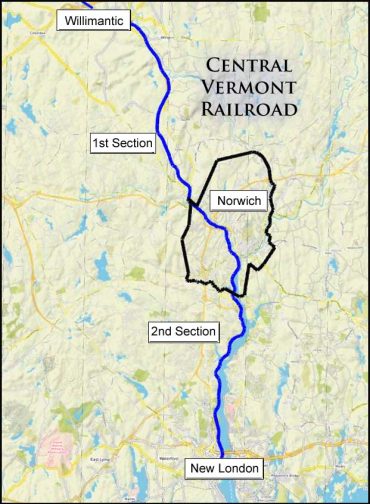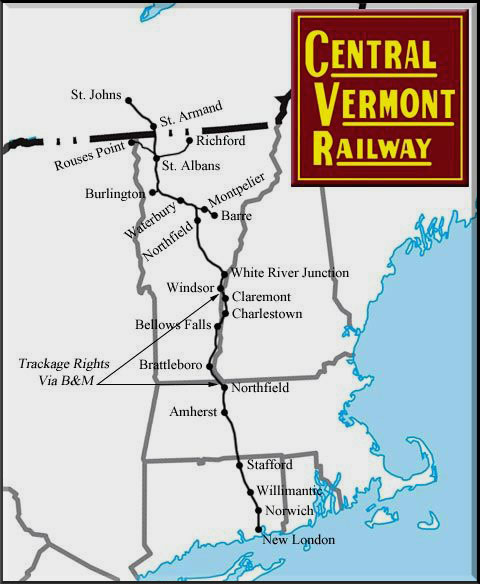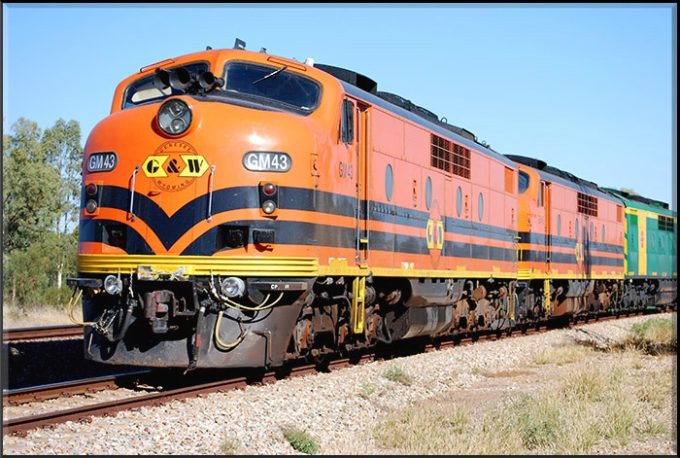NE Central RR Bridge at Yantic Falls
The present-day New England Central Railroad tracks have been owned and operated by many companies over the years. The first set of tracks that connected Norwich to New London, along the west bank of the Thames river was built in 1848. The first railroad company to operate on the tracks was the New London, Willimantic & Palmer Railroad.
New England Central trains still rumble through Norwich today on a regular basis. The top commodities transported are: Lumber, forest products, minerals, stones, petroleum products, and paper.
*Place cursor on image to magnify
Choose A New England Central Railroad Topic
*Place cursor on image to magnify
1848-1861
New London, Willimantic & Palmer Railroad
The New London, Willimantic & Palmer (NLW&P) Railroad was a forerunner of the Central Vermont Railway and today’s New England Central Railroad. When completed, the NLW&P line ran from New London north though Norwich, Willimantic, and onto Palmer Massachusetts.
The NLW&P was the first railroad to provide a direct rail line between Norwich and New London. Prior to 1848 travelers had to take a steamship from Chelsea Harbor to the mouth of the Thames.
The first section of rails, shown as a blue line in the map running from Norwich to Willimantic, was opened in September 1849. The second section, shown in red, from Norwich to New London was opened the next month. The extension, from Willimantic to Palmer, Massachusetts was opened by March 1850.

The locomotive shown here was one of the earliest used on the New London, Willimantic & Springfield. It was designed by T.W. Williams, and built in Taunton, MA in 1849. Its original name was the Willimantic but was renamed the T.W. Williams in 1856 for the company’s leader, Thomas W. Williams. He was William Williams’ younger brother.
The locomotive had four leading wheels, four large (54″) driving wheels and 15″ diameter pistons with a 20″ stroke.
*Place cursor on image to magnify
1848-1861
New London, Willimantic & Palmer Railroad
The New London, Willimantic & Palmer (NLW&P) Railroad was a forerunner of the Central Vermont Railway and today’s New England Central Railroad. When completed, the NLW&P line ran from New London north though Norwich, Willimantic, and onto Palmer Massachusetts.
The NLW&P was the first railroad to provide a direct rail line between Norwich and New London. Prior to 1848 travelers had to take a steamship from Chelsea Harbor to the mouth of the Thames.
The first section of rails, shown as a blue line in the map running from Norwich to Willimantic, was opened in September 1849. The second section, shown in red, from Norwich to New London was opened the next month. The extension, from Willimantic to Palmer, Massachusetts was opened by March 1850.

The locomotive shown here was one of the earliest used on the New London, Willimantic & Springfield. It was designed by T.W. Williams, and built in Taunton, MA in 1849. Its original name was the Willimantic but was renamed the T.W. Williams in 1856 for the company’s leader, Thomas W. Williams. He was William Williams’ younger brother.
The locomotive had four leading wheels, four large (54″) driving wheels and 15″ diameter pistons with a 20″ stroke.
New London, Willimantic & Palmer Train Accident (03/17/1853)
“I send you enclosed a rough sketch of a very singular railroad accident, which occurred on the 17th of the prior month, on the N.L. P. & Willimantic Railroad, about two miles below the city of Norwich Connecticut. The road winds along by the side of the beautiful river Thames, and the spot where the accident took place is one of the most romantic that could be imagined.” “As you can see by the drawing, a short curve is taken between the house and the ridge on the left. The train was under full headway – running too fast, detaching itself from the cars, and cut through and into the house on the right, tearing away.” Source: Illustrated News 04/16/1853Wood-engraving from the Illustrated News, April 16, 1853. The accident occurred about two miles south of the city of Norwich on March 17, 1853. A locomotive on the New London, Willimantic & Palmer Railroad ran off the track and ran into a house, detaching the kitchen and buttery. A woman inside the house was injured but no one was killed.
*Place cursor over image to magnify
Acknowledgements
Wikipedia
Railway & Locomotive Historical Society
JSTOR
1861-1872 New London Northern Railroad
The New London Northern Railroad (NLN) was a forerunner of the Central Vermont Railway. It operated from New London, Connecticut, north to Brattleboro, Vermont. Today, the railroad is operated by the New England Central Railroad. The New London Northern was the only through railroad in Connecticut not to come under the control of the New York, New Haven and Hartford Railroad.

The locomotive shown in the photo is the New London Northern 20 “Benjamin Stark”. It was later named the Central Vermont 170. The Benjamin Stark was built by the Manchester Locomotive Works in 1872 and scrapped in 1899.
The NLN railroad was leased by the Vermont Central Railroad on December 1, 1871. A year later, on November 2, 1872, the NLN railroad was renamed to the ‘Central Vermont Railroad’.
Acknowledgements
Wikipedia
Railway & Locomotive Historical Society
Public Domain
1872-1995 Central Vermont Railroad


The blue line shown in the map on the left shows the location of the Central Vermont Railroad in the vicinity of Norwich. The map on the right, shows the entire Central Vermont Railway system in 1929. Passengers could ride the Central Vermont train from New London, to Norwich and then onto Brattleboro Vermont from the early part of the twentieth century until September 27, 1947.

In the photo caption above the 4-6-0 describes the wheel configuration for the locomotive. In this case: 4 wheels in front, 6 powered drive wheels, and 0 wheels trailing the drives wheels.
On December 1, 1871 the Central Vermont Railroad began leasing New London Northern’s railroad line from Norwich to Brattleboro, Vermont. Almost a year later, on November 2, 1872, the New London Northern was renamed to the ‘Central Vermont Railroad’. The line became Central Vermont’s Southern Division. It operated in Connecticut, Massachusetts, New Hampshire, New York, and Vermont, as well as the Canadian province of Quebec.
Over the years the ownership and operation of the lines that run through Norwich has changed hands many times. The table below provides an overview of most of the major changes.
| Year | Event |
|---|---|
| 1871 | Lines leased from New London Northern Railroad |
| 1872 | Lines leased from New London Northern Railroad |
| 1844 | Consolidated Central Vermont Railroad with Vermont and Canada Railroad. Retained the Central Vermont Railroad name |
| 1896 | Entered into receivership and was bought by Grand Trunk Railway |
| 1899 | Sold at a foreclosure sale and was renamed to 'Centeral Vermont Railway' |
| 1927 | Went into receivership again |
| 1930 | Reorganized and became owned & operated by Canadian National Railway. Retained the name 'Central Vermont Railway'. |
| 1947 | Passenger service between New London and Brattleboro ceased |
| 1950's | Diesel locomotives begin to be used |
| 1957 | Last use of steam locomotives |
| 1995 | Bought by RailTex. Central Vermont Railway was renamed to 'New England Central Railroad' |
Acknowledgements
Wikipedia
American-Rails.com
The complete list of sources may be found by clicking the “Bibliography” button, and, then entering “Central Vermont” in the SEARCH box.
1891-1901 Union Depot
The photo above of the Union Depot was taken in 1898. It is a view, looking south down the Yantic River channel. It is a photo of the original depot built in 1891. When this photo was taken in 1898, the New England Central Railroad was operating the railroad. Later in 1901, the depot was rebuilt on a more substantial and safer foundation. Refer to the next placemark.
Acknowledgements
“Norwich,” 2003, p 40, by Dale Plummer
The complete list of sources may be found by clicking the “Bibliography” button, and, then entering “Union Depot” in the SEARCH box.
1901-1938 Norwich Union Station
The photo above of the Norwich Union Station was taken in 1929 by Lewis H. Benton. It is a view of the depot that was built in 1901. At the time when this photo was taken, the Central Vermont Railroad was operating the railroad. This building had been built on a more substantial and safer foundation than the original 1891 building.
According to Info Source:
“In Benton’s photo, the main line of the Central Vermont Railway, lessor of the NLN, is at the left, and the New York, New Haven & Hartford Railroad connection is at the right. Norwich Union Station was built over the west channel of the Yantic River, and was severely damaged by flooding in the Hurricane of 1938.”
Acknowledgements
University of Connecticut Library
Lewis H. Benton
1995-Present New England Central Railroad
The New England Central Railroad trains still rumble through Norwich today on a regular basis. The top commodities transported are: Lumber, forest products, minerals, stones, petroleum products, and paper.

The trains were initially powered by EMD GP38 locomotives, and later by EMD GP40 locomotives (shown in the photo above).
In 1995, the Central Vermont Railway was bought by RailTex Corp. RailTex renamed the Central Vermont Railway to the New England Central Railroad, (NECR). Within two years of operation the new NECR was handling more than 30,000 carloads annually.
The list below is a summary of owners since 1995:
1995-2000 Owned by RailTex
2000-2012 Owned by RailAmerica
2012-Present Owned by Genesee & Wyoming
Acknowledgements
Genesee & Wyoming Inc.
Wikipedia , The EMD GP40-2